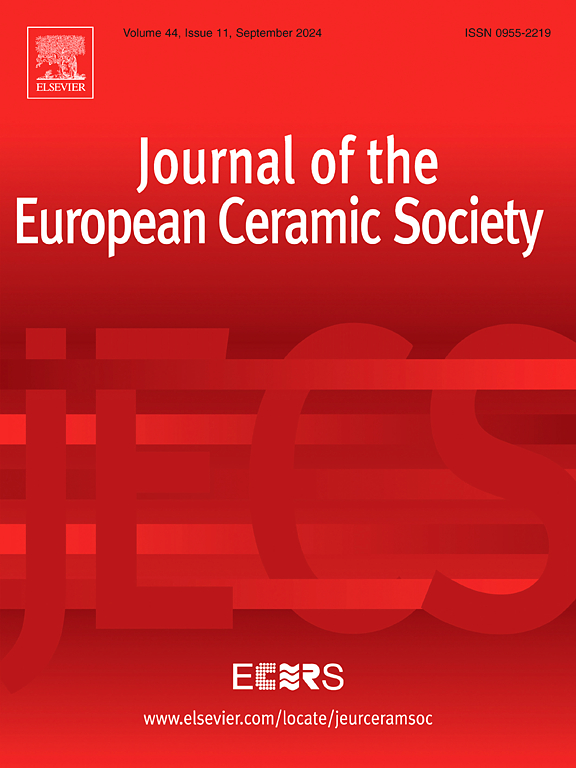Non-classical electromechanical behavior in multi-cation stabilized zirconia (Yb0.04Y0.04Gd0.04Nb0.10-Zr0.78O2-δ) ceramics
IF 6.2
2区 材料科学
Q1 MATERIALS SCIENCE, CERAMICS
Journal of The European Ceramic Society
Pub Date : 2025-05-28
DOI:10.1016/j.jeurceramsoc.2025.117568
引用次数: 0
Abstract
This work aims to investigate the electromechanical properties of a new mixed tetragonal-cubic composition: multi-cation stabilized tetragonal zirconia polycrystal (MC-TZP) ceramics, stabilized by 2 mol% Yb2O3–2 mol% Y2O3–2 mol% Gd2O3–5 mol% Nb2O5. The evolution of microstructure, dielectric, mechanical, and ferroelastic properties was also characterized. The MC-TZP powder was synthesized by solid-state reaction and then consolidated by two sintering methods, i.e., hot pressing and conventional sintering. Hot pressing produced an ultrafine microstructure with small grains, while conventional sintering resulted in larger grains. Both ceramics samples exhibit large longitudinal electrostrictive (M33 ≥ 1 * 10−17 m2/V2) coefficients at 1 Hz and a typical frequency-related relaxation effect, with the hot-pressed material demonstrating a relatively higher M33 value. This enhancement correlates with improved electrical properties, characterized by a higher dielectric constant and electrical conductivity compared to the conventionally sintered counterpart.
多阳离子稳定氧化锆(Yb0.04Y0.04Gd0.04Nb0.10-Zr0.78O2-δ)陶瓷的非经典机电行为
本工作旨在研究一种新的混合四边形-立方组合物:由2 mol% Yb2O3-2 mol% Y2O3-2 mol% Gd2O3-5 mol% Nb2O5稳定的多阳离子四边形氧化锆多晶(MC-TZP)陶瓷的机电性能。并对其微观结构、介电性能、力学性能和铁弹性性能的演变进行了表征。采用固相反应法制备MC-TZP粉体,并采用热压和常规烧结两种烧结方法进行固结。热压形成晶粒细小的超细组织,而常规烧结形成晶粒较大的超细组织。两种陶瓷样品在1 Hz时均表现出较大的纵向电致伸缩系数(M33≥1 * 10−17 m2/V2)和典型的频率相关弛豫效应,其中热压材料的M33值相对较高。这种增强与改进的电性能相关,其特点是与传统烧结对应物相比,具有更高的介电常数和电导率。
本文章由计算机程序翻译,如有差异,请以英文原文为准。
求助全文
约1分钟内获得全文
求助全文
来源期刊

Journal of The European Ceramic Society
工程技术-材料科学:硅酸盐
CiteScore
10.70
自引率
12.30%
发文量
863
审稿时长
35 days
期刊介绍:
The Journal of the European Ceramic Society publishes the results of original research and reviews relating to ceramic materials. Papers of either an experimental or theoretical character will be welcomed on a fully international basis. The emphasis is on novel generic science concerning the relationships between processing, microstructure and properties of polycrystalline ceramics consolidated at high temperature. Papers may relate to any of the conventional categories of ceramic: structural, functional, traditional or composite. The central objective is to sustain a high standard of research quality by means of appropriate reviewing procedures.
 求助内容:
求助内容: 应助结果提醒方式:
应助结果提醒方式:


